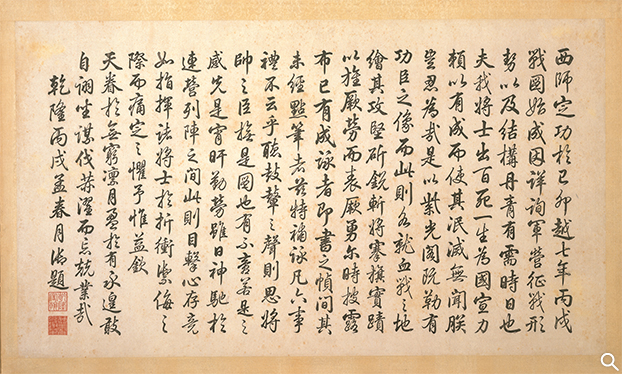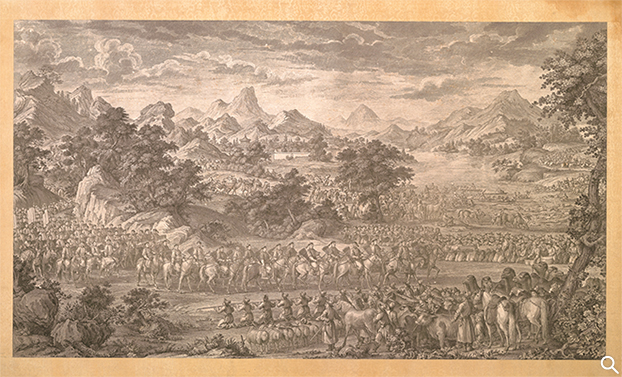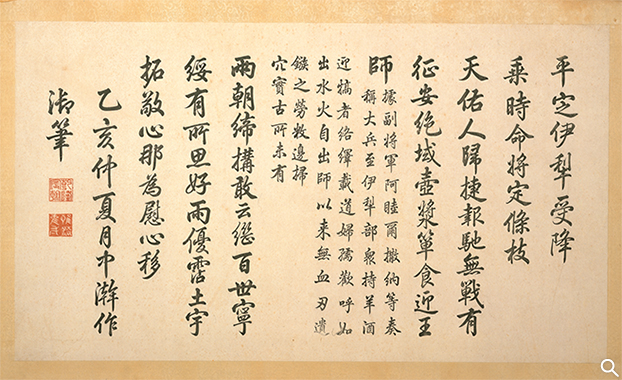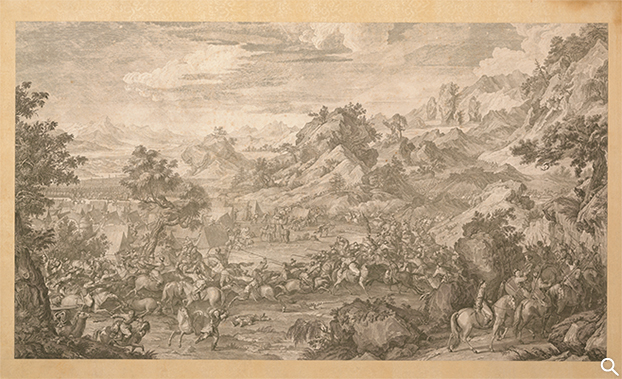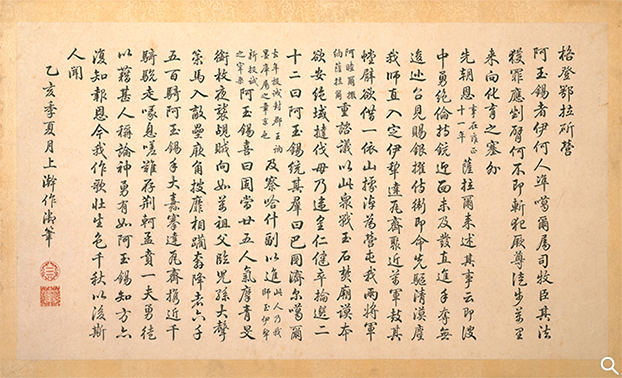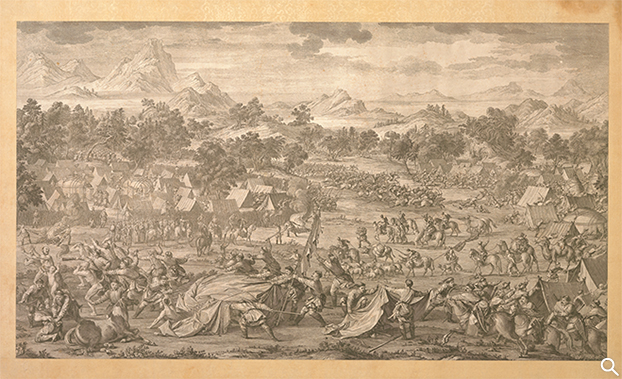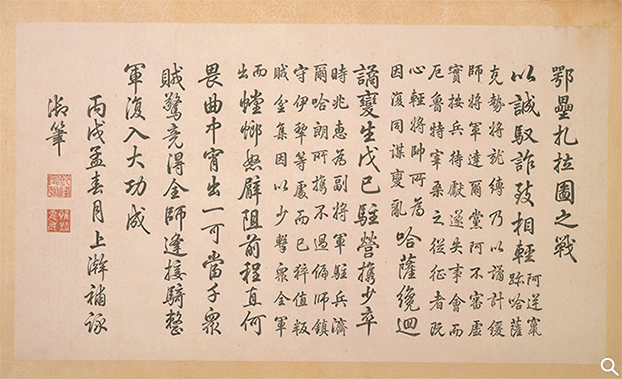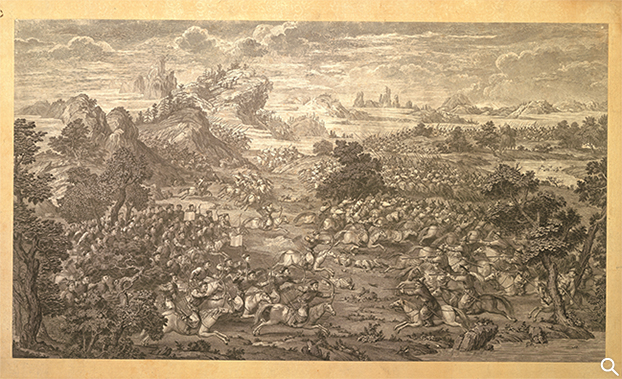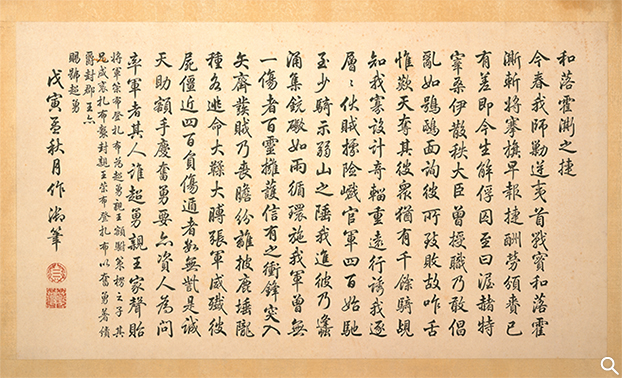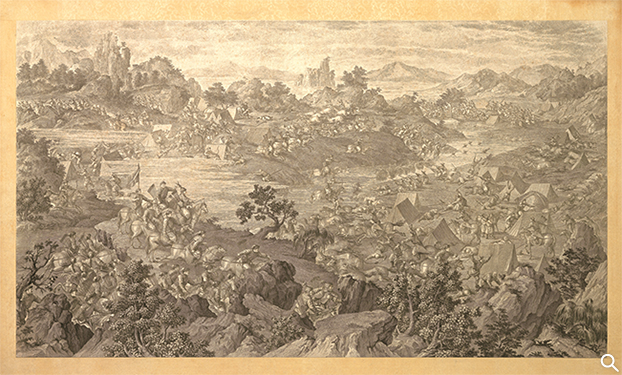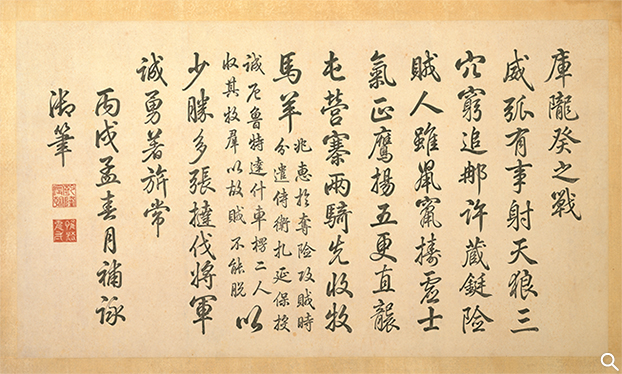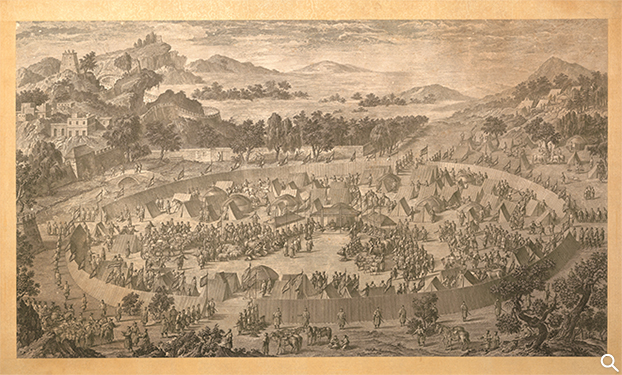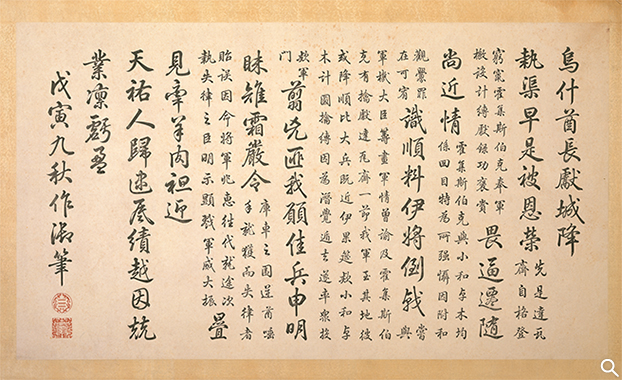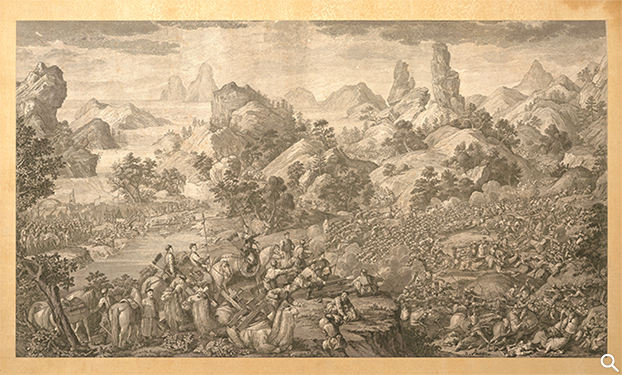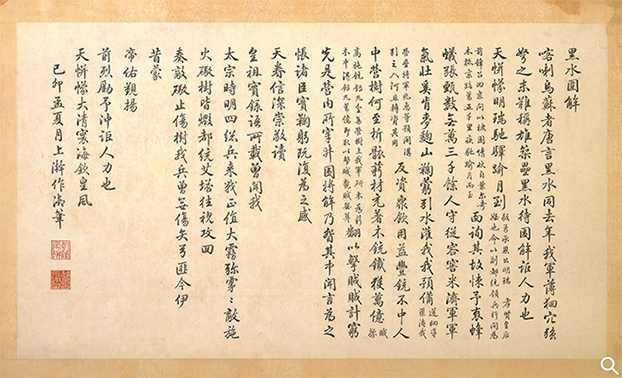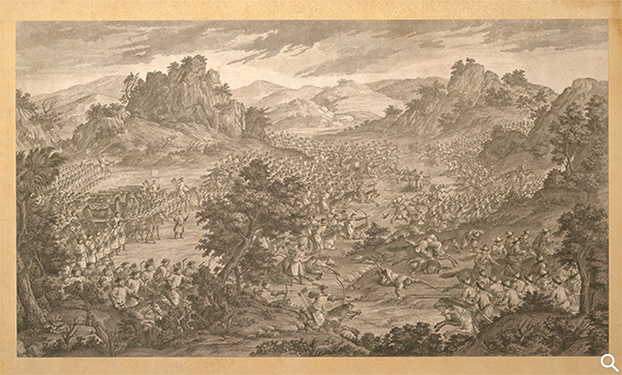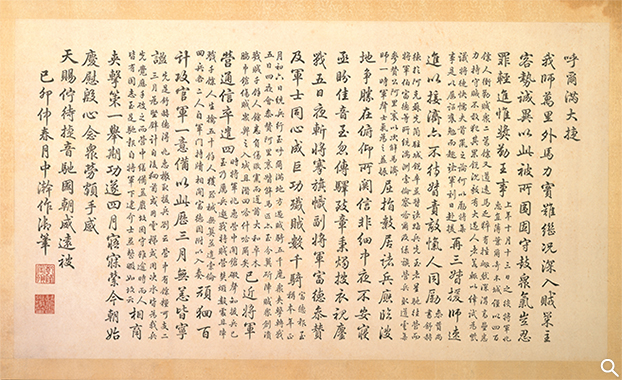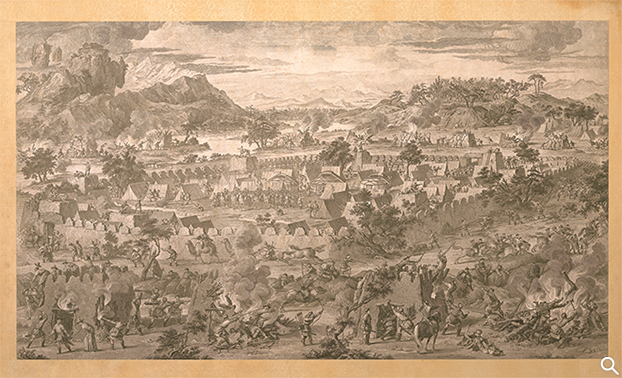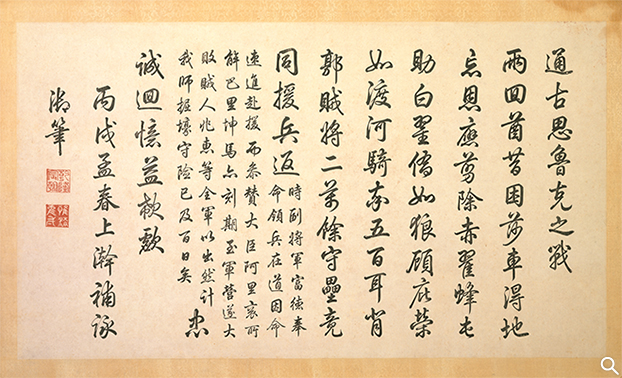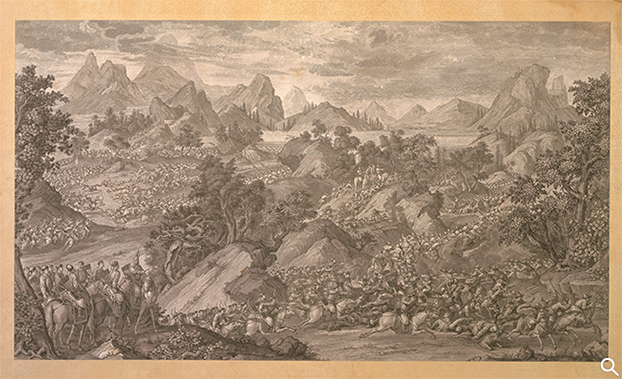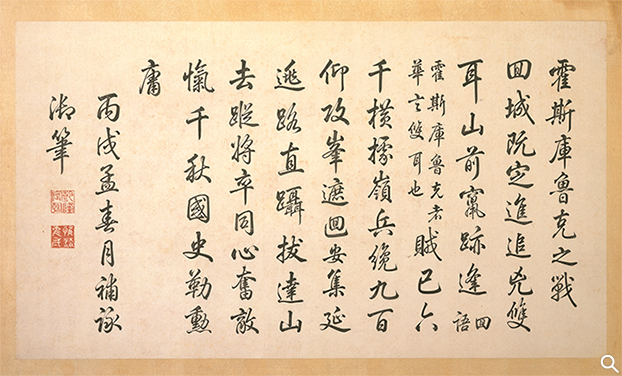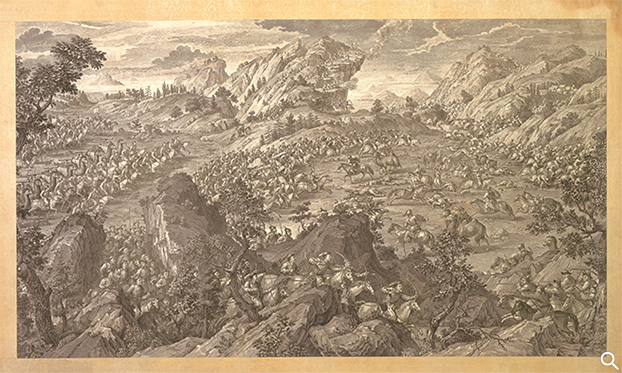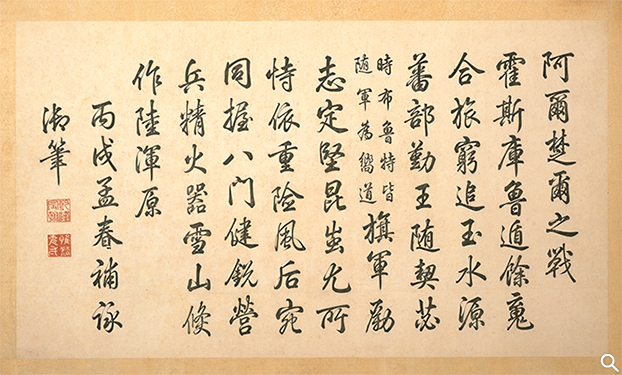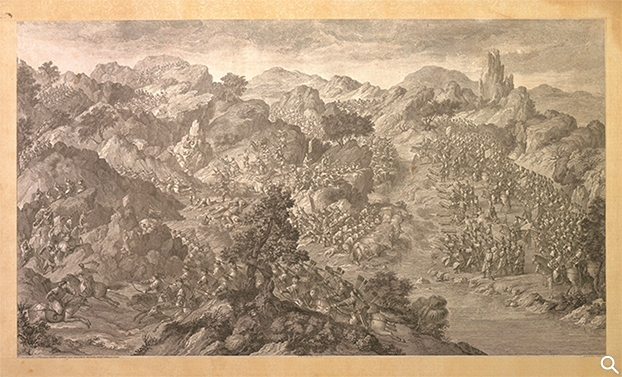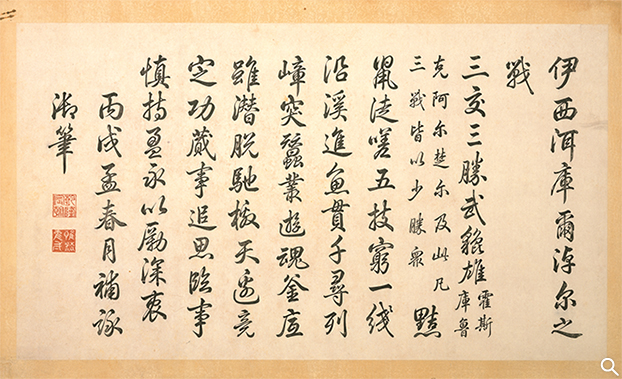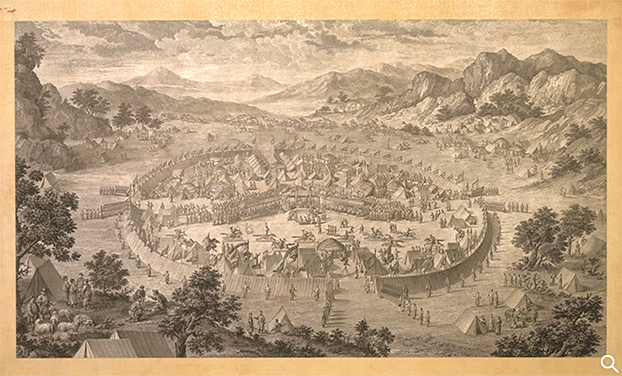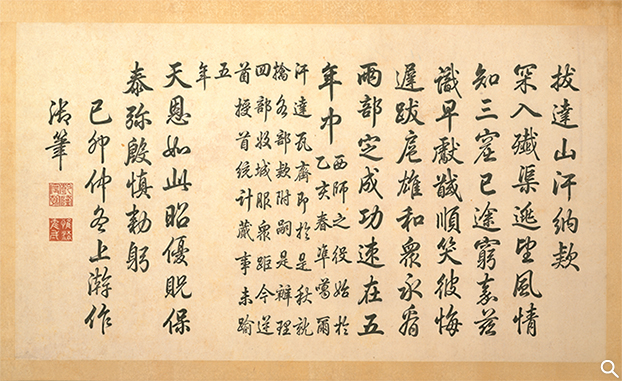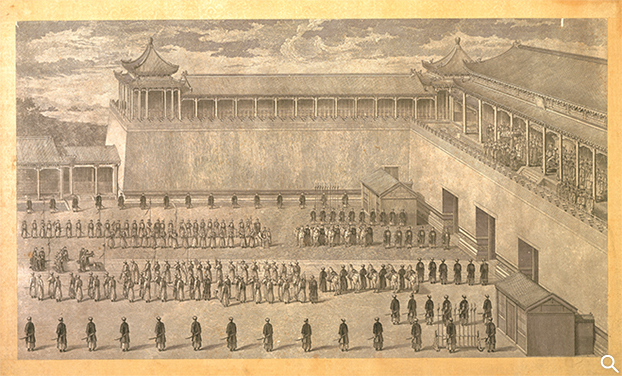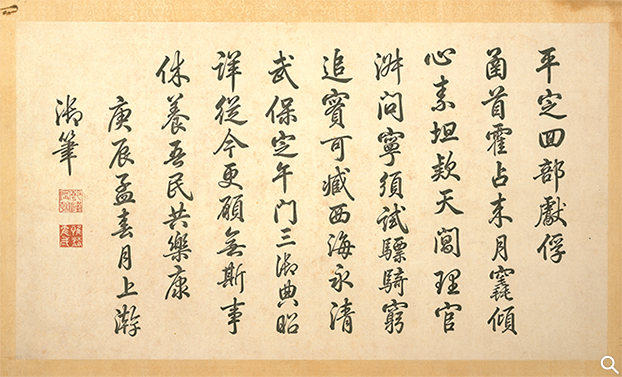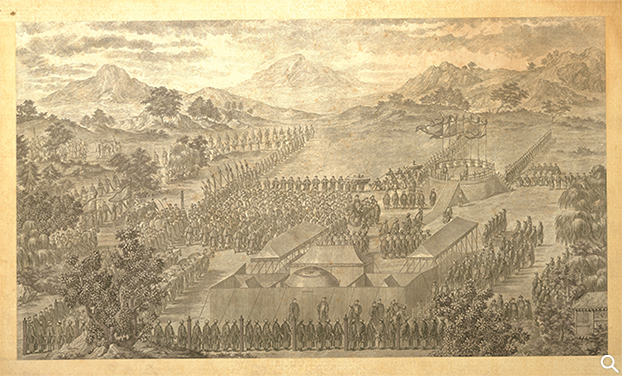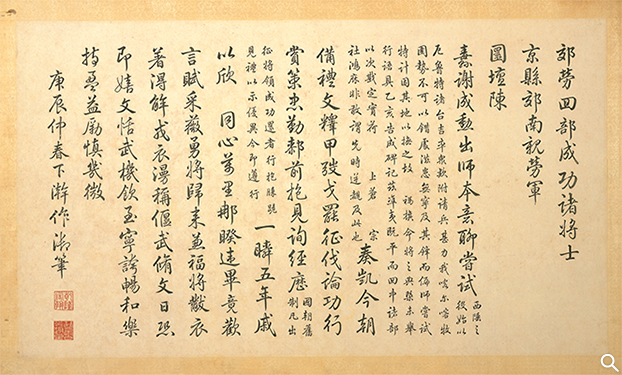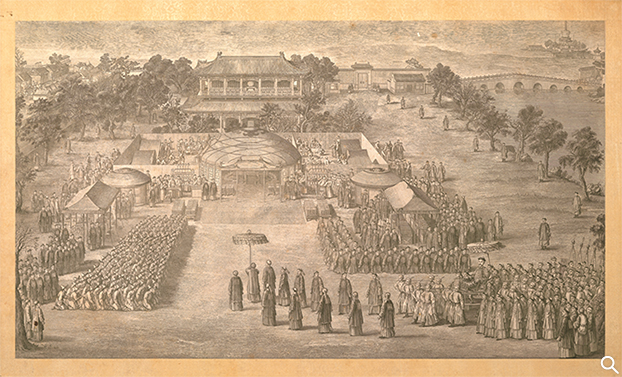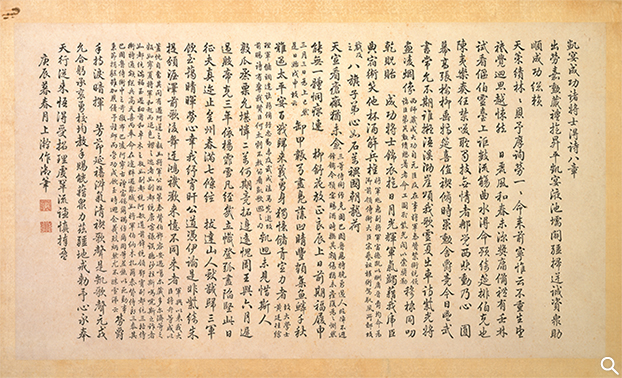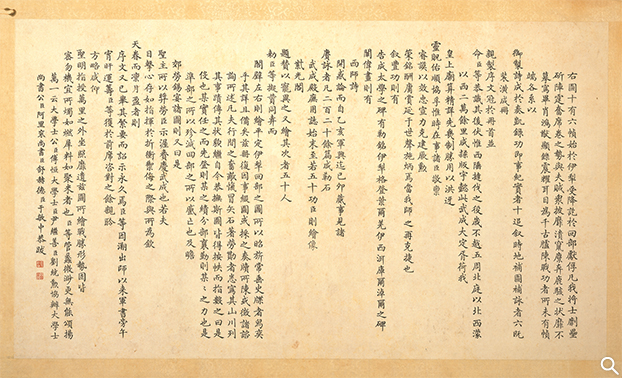Emperor Qianlong (1766)
58 cm × 95 cm
At the time when Giuseppe Castiglione and his associates finished the sketches of the Victory in the Pacification of Dzungars and Muslims and the Guangdong Customs shipped them to France for engraving, Emperor Qianlong was already so anxious that he could not wait but write a preface to the collection of copperplate prints, and decide on its album format for convenience of viewing. The Preface authored by the Emperor was written in the first month of his 31st reign year (1766). It is pointed out at the outset that the Emperor must grasp the details of the campaigns to ensure the authenticity of the illustrations, hence the long stretch of time required in the drawing of the sketches. He then went on to address the goals of making the illustrations. As all the outstanding commanding generals contributing significantly to the campaigns against the Dzungars and Muslims had been commended with individual portraits, it was essential that the brave, courageous officers and soldiers who went in harm’s way in the service of the empire be acknowledged, so that their military accomplishments and heroic deeds might be preserved to all eternity. Finally, Emperor Qianlong noted, as he perused the illustrations and reflected upon the combats his troops engaged in as well as the blessings of Heaven, that he should not be pompous about the victory, but remain increasingly cautious and conscientious. (Cheng Wing-cheong)
Drawing Drafter: Ignatius Sickltart, 1708-1780
Project Manager: Charles-Nicolas Cochin, 1715-1790
Copperplate Engraver: B. L. Prevot, birth and death dates unknown
Completion Year: 1769
Drawing Drafter: Giuseppe Castiglione, 1688-1766
Project Manager: Charles-Nicolas Cochin, 1715-1790
Copperplate Engraver: J. Ph. Le Bas, 1707-1783
Completion Year: 1769.
58 cm × 95 cm
Also known as “Kalmuk Ayūsi Attacking Dawaachi’s Camp on Mount Gädän,” this illustration depicts a decisive battle where the Qing army defeated the Dzungars and gained control over the northern marches of the Tianshan Mountain. The historical account goes that one night in the late spring of 1755, General Ayūsi (n.d.), who was a former enemy surrendered to Qing, took twenty two horsemen to launch a surprise attack against the main camp of Dawaachi (?-1759), the Dzungar rebel leader. In this illustration, we can see Dawaachi’s camp at Gädän-Ola was heavily defended and equipped with several cannons. Ayūsi approached the enemy camp from a hidden trail. However, he was found by the enemy. All of a sudden, Ayūsi charged into the enemy camp with a lance, followed by his horsemen. He bravely entered enemy territory without any fear. Dawaachi’s soldiers were taken by surprise, and so scared that they ran into each other.
This illustration was drafted by Giuseppe Castiglione (1688-1766), who rendered the scene on the battlefield rather realistically. By finely presenting the human figures’ facial expressions and emphasizing spatial depth, the viewer can easily feel the sense of danger of the campaigns and the tension of men against men. We can see Ayūsi, riding a black horse with a lance in hand, stabbed his weapon into an enemy’s chest. After the end of the battle, Emperor Qianlong not only commissioned Giuseppe Castiglione to paint Ayūsi Scattering Rebels with Upraised Spear, but also wrote a poem to tell the story and praised his loyalty and bravery.
Having been drafted by Castiglione, the sketch was sent to Paris for engraving in 1775. The project was directed by the famed engraver Charles- Nicolas Cochin (1715-1790), and the craftsman assigned to the task, Jacques Philippe Le Bas (1707-1783), was then already a master artisan. His name is engraved on a rock at the lower part of the illustration. In 1779 the engraving was completed, and the prints were shipped back to China by the French East India Company the following autumn. (Cheng Wing-cheong)
By Emperor Qianlong
Engraved by the Qing Imperial Household Department.
58 cm × 95 cm
Drawing Drafter: Unknown
Project Manager: Charles-Nicolas Cochin, 1715-1790
Copperplate Engraver: J. Ph. Le Bas, 1707-1783
Completion Year: 1770
Drawing Drafter: Denis Attiret, 1702-1768
Project Manager: Charles-Nicolas Cochin, 1715-1790
Copperplate Engraver: J. Ph. Le Bas, 1707-1783
Completion Year: 1774
Drawing Drafter: Joannes Damasceuns Salusri, ?-1781
Project Manager: Charles-Nicolas Cochin, 1715-1790
Copperplate Engraver: Jacques Aliamet, 1728-1788
Drawing Drafter: Joannes Damasceuns Salusri, ?-1781
Project Manager: Charles-Nicolas Cochin, 1715-1790
Copperplate Engraver: Pierre-Philippe Choffard, 1730-1809
Completion Year: 1774
Drawing Drafter: Giuseppe Castiglione, 1688-1766
Project Manager: Charles-Nicolas Cochin, 1715-1790
Copperplate Engraver: J. Ph. Le Bas, 1707-1783
Printed in Paris, 1771.
58 cm × 95 cm
Known in Mongolian as Karausu, the Black Water River is on the upstream of Xinjiang’s Yarkand River. The “Lifting of the Siege at the Black Water River,” drafted by Giuseppe Castiglione, depicts the story of the Qing general Zhaohui (1708-1764) and his legendary break-out of a blockade. In the early spring of 1759, General Zhaohui and his troops were besieged by rebels in Yarkand until the arrival of reinforcement. Emperor Qianlong wrote a poem “Lifting of the Siege at the Black Water River” to describe the battle in detail.
The hardship and difficulties experienced by the Qing army can be inferred from the densely layered mountains and clouds in the background. The Qing’s fortification is on the left side. General Zhaohui, holding his horsewhip high in the air, is placed at the center. Calm and collected, he is in full armor and directs the soldiers with confidence. His fortitude and persistence under pressure seem to have the power to keep his soldiers on an even keel, and to boost their morale. On the right side, the reinforcement forces coming to the rescue launch attacks against the rebels from various fronts. While the various parts of the illustration were drawn separately in different times, they were seamlessly patched together, attesting to Castiglione’s dexterity in illustrating battlefield scenes. It is also an authentic and vivid record of the Qing army’s defeat of the rebels.
The sketch was sent to France for engraving by the master engraver Jacques Philippe Le Bas. The engraving was finished in 1771, and the copperplate and the prints were shipped back to China the next year. (Cheng Wing-cheong)
By Emperor Qianlong.
Engraved by the Qing Imperial Household Department.
58 cm × 95 cm
Drawing Drafter: Joannes Damasceuns Salusri, ?-1781
Project Manager: Charles-Nicolas Cochin, 1715-1790
Copperplate Engraver: Augustin de Saint-Aubin, 1736-1807
Completion Year: 1770
Drawing Drafter: Unknown
Project Manager: Charles-Nicolas Cochin, 1715-1790
Copperplate Engraver: Augustin de Saint-Aubin, 1736-1807
Completion Year: 1773
Drawing Drafter: Unknown
Project Manager: Charles-Nicolas Cochin, 1715-1790
Copperplate Engraver: B. L. Prevot, birth and death dates unknown
Completion Year: 1774
Drawing Drafter: Denis Attiret, 1702-1768
Project Manager: Charles-Nicolas Cochin, 1715-1790
Copperplate Engraver: Jacques Aliamet, 1728-1788
Drawing Drafter: Joannes Damasceuns Salusri, ?-1781
Project Manager: Charles-Nicolas Cochin, 1715-1790
Copperplate Engraver:
Completion Year: 1772
Drawing Drafter: Joannes Damasceuns Salusri, ?-1781
Project Manager: Charles-Nicolas Cochin, 1715-1790
Copperplate Engraver: Pierre-Philippe Choffard, 1730-1809
Completion Year: 1772
Drawing Drafter: Denis Attiret, 1702-1768
Project Manager: Charles-Nicolas Cochin, 1715-1790
Copperplate Engraver: Louis-Joseph Masquelier, 1741-1811
Drawing Drafter: Joannes Damasceuns Salusri, ?-1781
Project Manager: Charles-Nicolas Cochin, 1715-1790
Copperplate Engraver: Denis Née, 1732-1818
Completion Year: 1772
Drawing Drafter: Unknown
Project Manager: Charles-Nicolas Cochin, 1715-1790
Copperplate Engraver: J. Ph. Le Bas, 1707-1783
Completion Year: 1770
Written by Fu Heng, et al.
Qianlong reign, Qing dynasty
58 cm × 95 cm
Appended to the sixteen copperplate prints, the postscripts were written by the Grand Secretary Fu Heng (1720-1770) and other court officials, such as Grand Secretaries Yin Jishan (1695-1711) and Liu Tongxun (1698-1773), as well as Ministers Arigun (?-1769), Shu Hede (1710-1777) and Yu Minzhong (1714-1779), who either fought on the battlefield, attended to logistics management, or took part in the compilation of military annals. Among them, Fu Heng, Arigun and Shu Hede were even given the honor of being portrayed as meritorious statesmen, whose portraits were displayed at the Ziguangge Pavilion.
These postscripts were written circa 1766. While most of the compositions are full of laudatory words praising the Emperor’s superior military might, they do point out that the Emperor, in commemoration of the victory in pacifying the Dzungars and Muslims, had commissioned the making of documentary literature, stele inscriptions and literary compositions on the campaigns, as well as artistic portraits honoring those with outstanding service. Of these, the production of the sixteen copperplate engravings was undoubtedly the most important celebratory undertaking with an artistic touch at the time. To those who fought in the campaigns, a viewing of the illustrations should bring them back to their time on the battlefield, and they would certainly indulge themselves in a sense of glory. (Cheng Wing-cheong)

